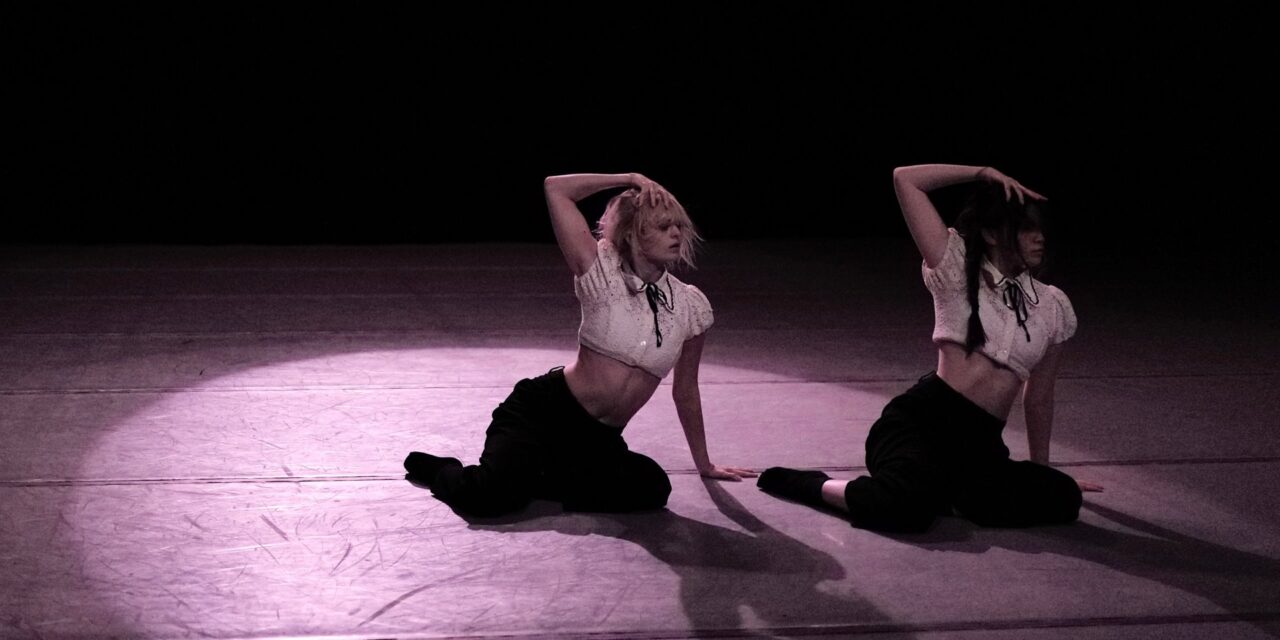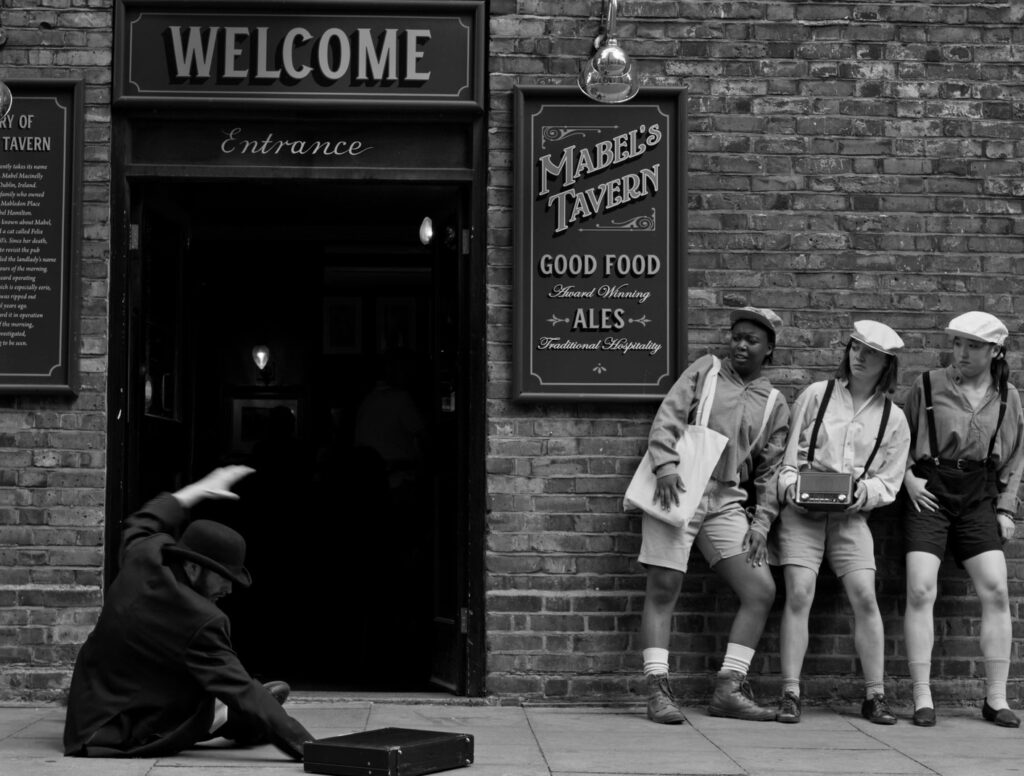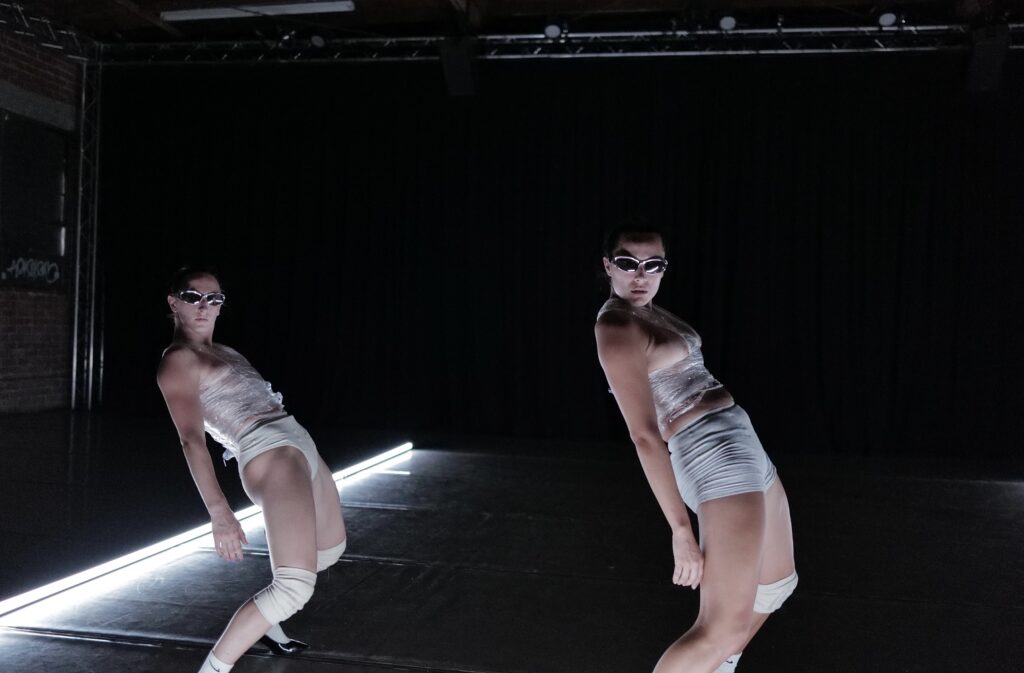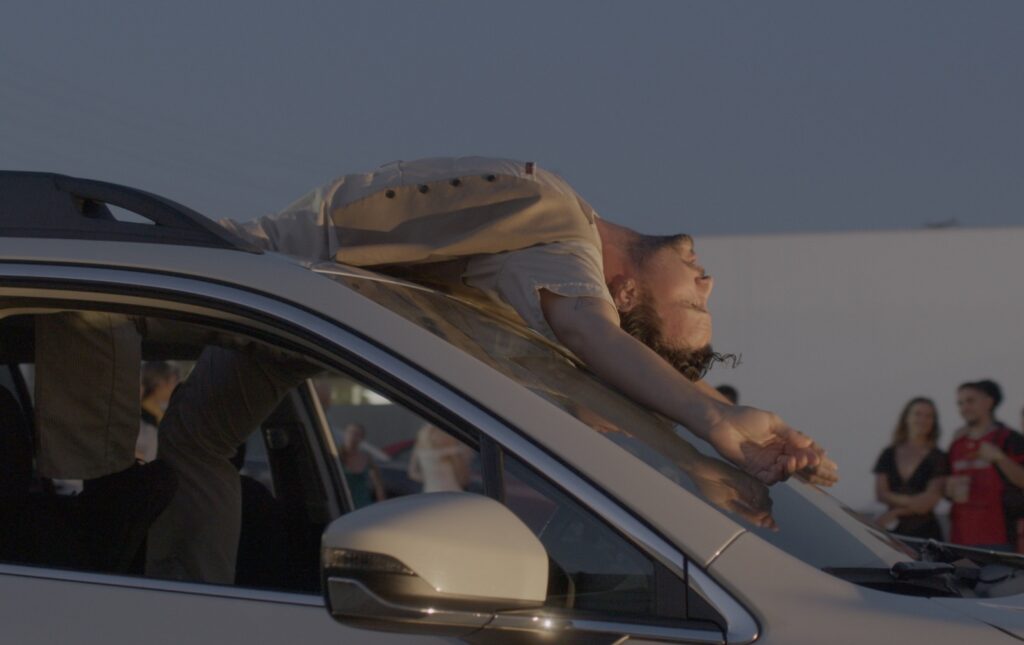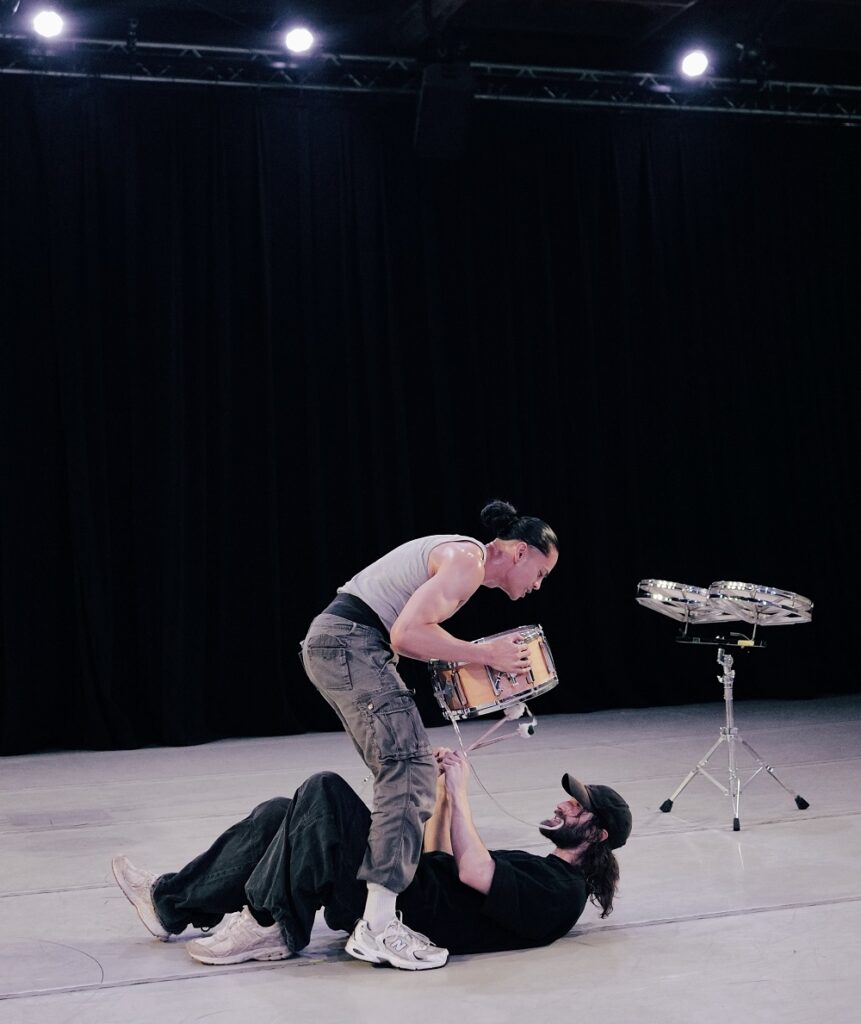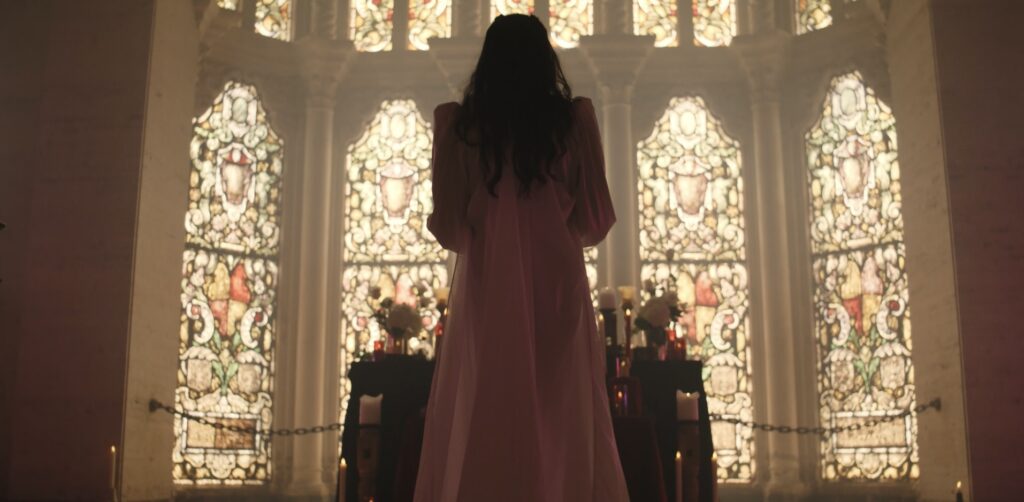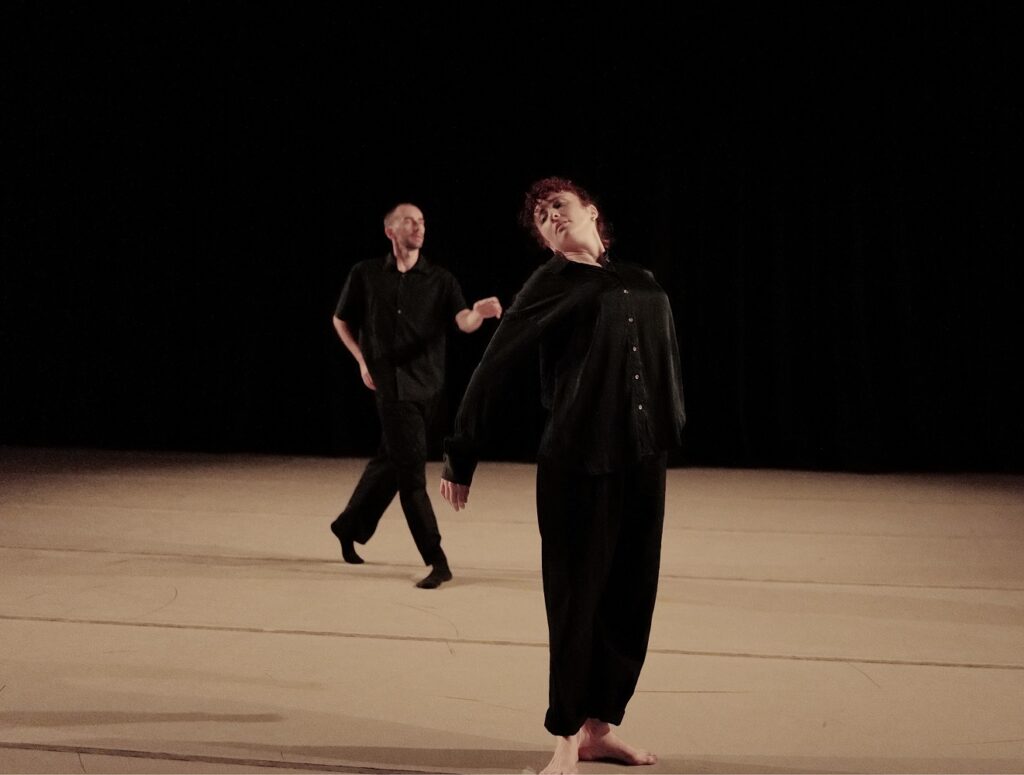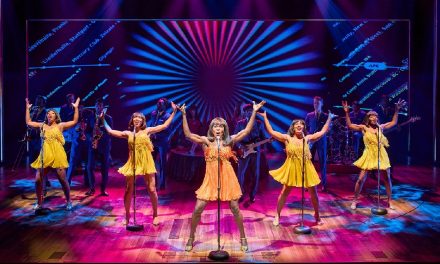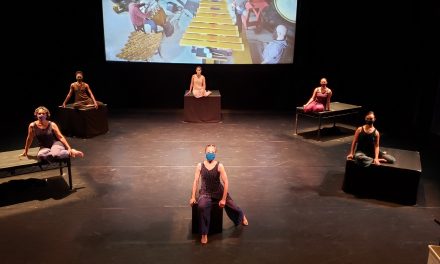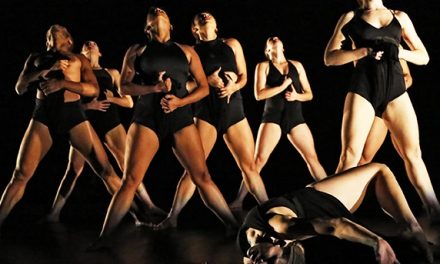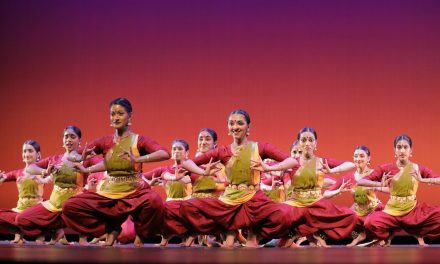On Friday, July 11, 2025, at LA Dance Project, I witnessed an evening of dance that represented the goals of TheSpace_LA: to make LA a creative hub for both local and international voices. The night included works by local artists and a collaborative work set on the 19 participants from all over the world of The Space’s Performance Lab. As a whole, artists played with gesture, genre, and musicality. While LA is figuring out its place in the world of concert dance, it is sure in its identity as the center of film and commercial dance. I think that this evening showed how our film and commercial dance sensibilities can influence and shape LA’s unique flavor of concert dance.
Arriving at LA Dance Project, tacos and a bar allowed a space for the audience to connect and mingle outside, and a montage of films from Mike Tyus & Co. played on the wall inside the lobby. The films ranged in setting, and the videography and editing worked to emphasize the overall feeling of each film. In one film, the camera was steadier, peeking around plastic tarps hung in a warehouse, and I felt like a hidden observer of the interactions. Wider shots showed off the expanse of a desert setting or the white void of art galleries, while tighter shots in another film highlighted the tangled cluster of limbs of a pile of dancers. All showed the strong choreographic and cinematic vision of Tyus and his collaborators and were an introduction to some of the movement styles we would see live.
The first work of the evening, “Thread Lightly,” was performed and choreographed by Madison Lucas and Ella Melideo. Lucas and Melideo’s work started and ended with them seated and clapping their hands like children on a playground. From these initial simple percussive patterns, the choreography complexified, and they manipulated and contorted in and out of intriguing twisted shapes. As the piece progressed and they separated, I enjoyed the way they wove in larger technical feats that contrasted the smaller precise details. The use of the initial clapping pattern set up the feeling that they had an internal rhythm or shared heartbeat that drove their actions and reactions.
“Marrow,” was a creative piece choreographed and performed by Majella Bess, director of TheSpace_LA, that played with the audience’s perception and acrobatic elements. Bess dressed in all black, revealing only her shins and forearms creating shapes and patterns in the dim spotlight. It reminded me of videos I’ve seen of dancers tutting in large groups, letting the sea of forearms create designs. In this live presentation, it was cool to shift my own focus and watch the patterns Bess created with her arms and legs and then to zoom out and appreciate the way she had to move her whole body to make these effects. I especially enjoyed some of the repeating traveling actions, like an impressive hip bridge rolling up over the top of her hands to a backbend. There were some moments earlier in the piece that could be more precise with the shapes made, but I enjoyed Bess’ choreographic exploration and was impressed by her movement quality.
Next up, “The Enemy of Your Enemy” was a film by the director of Performance Lab, Jessie Lee Thorne, created while studying film earlier this year in London. The black and white film fused dance, theatrics, and physical comedy together while telling the story of a drunk getting pickpocketed. There was a quirkiness to Throne’s choreography that matched well with the photoplay music. The cinematography was strong; the camera would drunkenly sway to emulate the mental state of the inebriated characters, and Thorne seemed to use longer or shorter shots to manipulate our sense of time.
“CLACK (WIP)” was a strong work presented by Mike Tyus & Co. in collaboration with the dancers, Isabella Caso and Taylor Lopez. Eight long tube lights were arranged on the stage in a U shape, and as the lights shifted to a stark bright white, one of the dancers stomped out from behind the back curtains. The costuming was bizarre and futuristic: white spandex bottoms, white Nike socks, black heels, shiny silver glasses, and a tube top of saran wrap. The only sounds came from the dancers’ percussive stomps and slaps. The dancers’ deadpan stares, sometimes staring directly at the audience, clunky stomps, odd movements, and extended pauses in outlandish poses created a humorous viewing experience. I enjoyed the way this piece used acrobatic backbends, angular and broken shapes, and humor. There was an interesting dichotomy in the way the dancers were awkward and seemingly uncoordinated with their stomps and folds, while executing movements that required immense precision and strength.
The next piece was a site specific work that took place in the outdoor space and parking lot of LA Dance Project. “Passion Fruit Grove” was directed and choreographed by Ramond Ejiofor and danced by Co-eL Rodriguez, Colleen Loverde, and Judson Emery. The piece mostly featured duet work: first between Loverde and Rodriguez, and then between Rodriguez and Emery. It felt intentional that the male-female duet took place in a more public setting by the bar, while the two men connected in a more hidden, intimate area that we were led to. The dancers were impressive, spryly climbing cars, fences, and shipping containers. I was particularly drawn by some of the sections involving the car, where some of the dancers slid smoothly in and out of the windows and sun roof. The cuing for the audience was well done – it was clear when we were supposed to move or shift our focus, and in a few moments where I felt like the movement was becoming totally obscured, it became clear that it was the point and that I was supposed to look elsewhere.
Back in the studio, “IMMDED IMGEWD” was a funny escalating back and forth between dancer, Jobel Medina, and drummer, Elliott L Sellers. Medina is a fantastic mover and his movements were often ballet-influenced and featured clean lines, impressive athleticism, and deep plies. As the piece progressed, his movements became more erratic, angular, and pulsing, seeming to be driven by the challenge brought by Sellers’ complex drumming. Sellers also had to adapt to Medina, finding ways to keep a rhythm going as Medina removed pieces from his drum set. The piece felt like more of an exploration than a finished product, but it was nonetheless an enjoyable, playful banter between dancer and musician.
“UNHOLY RAPTURE” was another short film, choreographed and directed by Jennifer Rose. Featuring Reshma Gajjar, the film took place in a church. Gajjar prays with her rosary at an altar, dressed in all white. Eventually, she sees dark gloved hands emerge from the altar, and her reaching, pleading movements become more clawing and desperate. She gives in to this unholy “Entity,” played by Pavel Vine, and is thrown around by him as she writhes with pleasure. The quick cuts of the camera amplify the emotion of her release. Often, all we see of this Entity are his dark gloved hands on her white clothing. After she is carried away, draped in his arms, and the credits roll, Gajjar’s face appears once again, as if we are receiving her confession, and she coyly quips “Forgive me Father, for I have sinned.” This film leaned into the melodramatic at times but was well-constructed and used the camera work effectively to bring the vision to life.
The penultimate piece, “Once, & For All,” seemed to show us the journey of a relationship – the desire for connection, the initial spark, the ups and downs, and eventually the dissipation and possible dissolution of the pairing. The work was created and danced by Megan Doheny and Ilya Nikurov, who were solid performers in their dancing and emotion. Their choreography contrasted softer, lilting waltz-like movements with sharper angularity, later showing more intense physicality as they shook and thrashed on the floor. The ending of the piece was a bit unclear to me after a strong overall arc and could be worked out more to either create a clear ending or to make the choice to leave us wondering what happened – for this viewer, it fell somewhere in the middle.
The final piece of the night, “beaten soft” was the collaborative product of Performance Lab, facilitated by Mike Tyus & Co. and performed by the 19 artists who had come together from around the world over the last two weeks. The work felt dystopian and seemed to comment on the way that we engage with, or ignore, human suffering around us. “beaten soft” utilized a metal table, and the first visual was of two bodies on the two levels of the table, with their neutral-toned attire making them look like bodies ready for autopsy. Others began to enter and coldly manipulate them. During sections with the full group onstage, Tyus often juxtaposed military-like emotionless walking or marching with a few dancers moving with more fluidity and complexity, as well as moments of well-constructed, intertwining, partner or group work. Various sections with smaller arrangements of dancers occurred, featuring more athletic, percussive choreography.
Tyus’ choreography plays with gravity. At times, dancers would show immense control as they moved smoothly up from the floor, but at other times, they would move with amplified heaviness or even throw themselves at the ground. There was also great use of floorwork, and despite the short time frame, the dancers were incredibly synchronized and connected. If the work is continued, the overall structure and transitions between the smaller sections could be developed further to give more of a why for the various entrances and exits to set up the sections, and to use the sections to connect the dots more from where the piece started and ended. For something created in two weeks with an unfamiliar group, it was an impressive feat and the dancers rose to the challenging and complex choreography, and “beaten soft” capped off a truly dynamic evening of dance.
The dancers who performed and collaborated on this final piece were Adam Ross, Meena Manoj, Chloe Rauch, Madison Ostrach, Olivia Johnson, Elly Rokeach, Mark Medrano, Jenna Wu-Cardona, Julieta Alvarez, Sage Melton, Tessa Kirk, ALissa Magno, Miana Abramson, Jacquelyn Tepper, Leslie Marfil, Sugar Stanley, Mia Moraru, Shanti Topzand, and Emilia Sandoval.
To learn more about Performance Lab, please visit their website.
For more information about TheSpace_LA, please visit their website.
Written by Rachel Turner for LA Dance Chronicle.
Featured image: Madison Lucas and Ella Melideo in “Thread Lightly” – Photo by Joy Isabella Brown.

